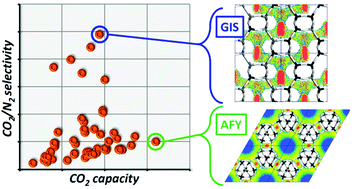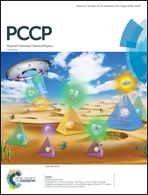Computational evaluation of aluminophosphate zeotypes for CO2/N2 separation†
Abstract
Zeolites and structurally related materials (zeotypes) have received considerable attention as potential adsorbents for selective carbon dioxide adsorption. Within this group, zeotypes with aluminophosphate composition (AlPOs) could be an interesting alternative to the more frequently studied aluminosilicate zeolites. So far, however, only a few AlPOs have been characterised experimentally in terms of their CO2 adsorption properties. In this study, force-field based grand-canonical Monte Carlo (GCMC) simulations were used to evaluate the potential of AlPOs for CO2/N2 separation, a binary mixture that constitutes a suitable model system for the removal of carbon dioxide from flue gases. A total of 51 frameworks were considered, all of which have been reported either as pure AlPOs or as heteroatom-containing AlPO derivatives. Prior to the GCMC simulations, all structures were optimised using dispersion-corrected density-functional theory calculations. The potential of these 51 systems for CO2/N2 separation was assessed in preliminary calculations (Henry constants and CO2 uptake at selected pressures). On the basis of these calculations, 21 AlPOs of particular interest were selected, for which 15 : 85 CO2/N2 mixture adsorption isotherms were calculated up to 10 bar. For adsorption-based separations using an adsorption pressure of 1 bar (vacuum-swing adsorption), AlPOs with GIS, ATN, ATT, and SIV topologies were predicted to be most attractive, as they combine high CO2/N2 selectivities (75 to 140) and reasonable CO2 working capacities (1 to 1.7 mmol g−1). Under pressure-swing adsorption conditions, there is a tradeoff between selectivity and working capacity: while highly selective AlPOs like GIS reach only moderate working capacities, the frameworks with the highest working capacities above 2 mmol g−1, AFY, KFI, and SAV, have lower selectivities between 25 and 35. To gain atomic-level insights into the host–guest interactions, interaction energy maps were computed for selected AlPOs. The computational assessment presented here can guide future experimental efforts in the development and optimisation of AlPO-based adsorbents for selective CO2 adsorption.



 Please wait while we load your content...
Please wait while we load your content...